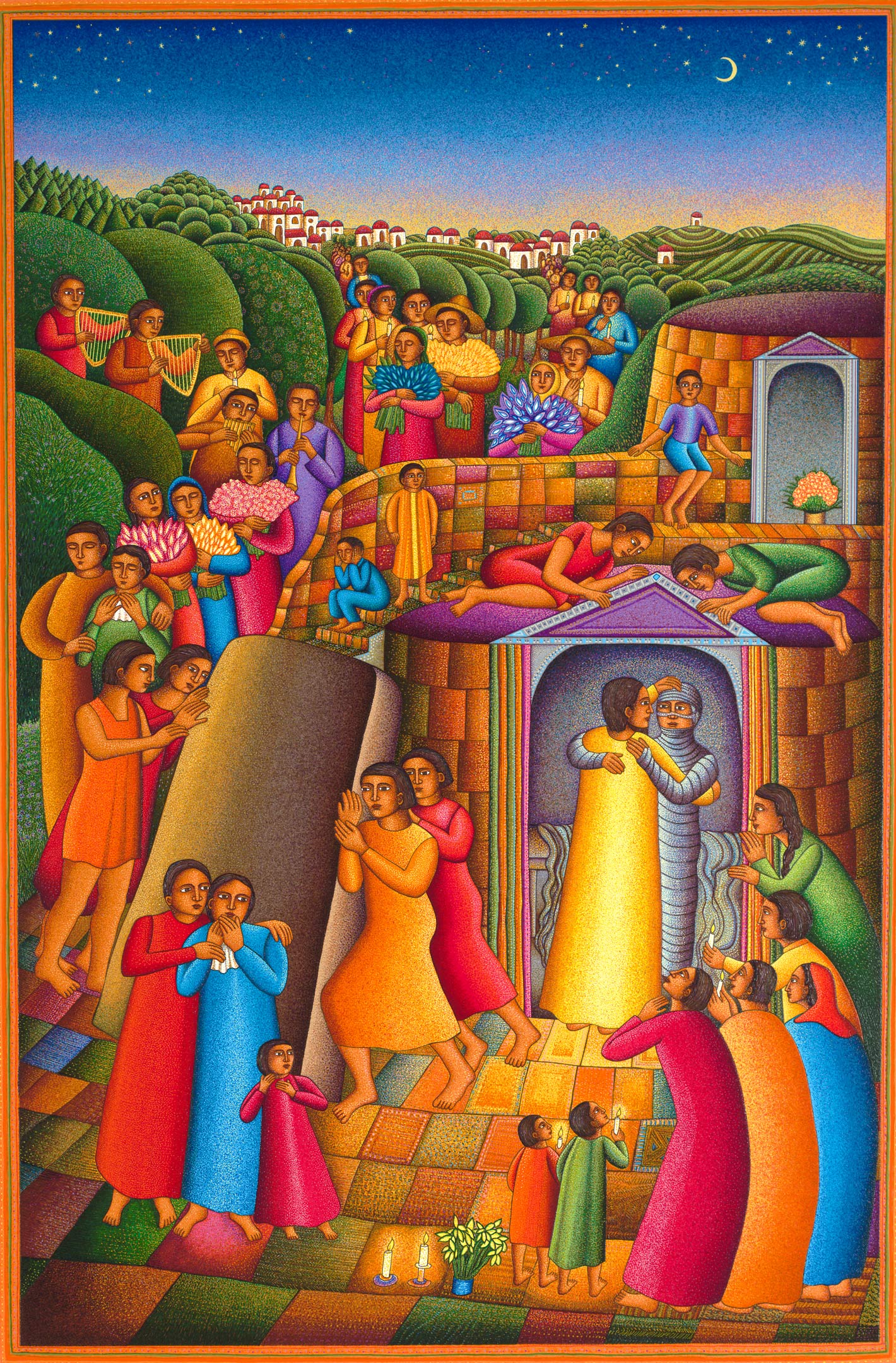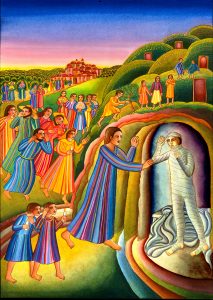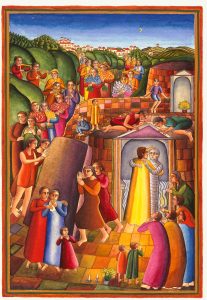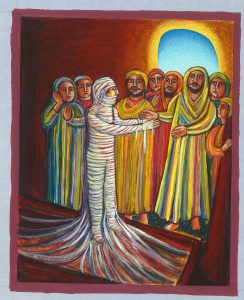Artist’s Notes
I created three paintings of the narrative THE RAISING OF LAZARUS from the Gospel of St. John. Before I began the paintings, I explored the story with many types of drawings, spanning 1989 to 1994. I used water colors, water media and acrylics for the paintings. TAKE AWAY THE STONE, the watercolor of 1993, was the painting I chose to develop into a serigraph edition.
My preliminary work for the serigraph edition began in June 2005. I redrew and increased the size of the image from 18″ x 12″ to 30″x 20″. This new drawing became the map to build and register the subsequent 57 colors printed. For each color, I drew a new stencil.
I like to work at the Aurora Serigraphic Studio with master printer, Jim Butterfield II. He has been my long-time collaborator, printing all my serigraph editions since 1993. With 30 years of printing experience, Jim is skilled in all the technical aspects and preparation of the printing screens. In the studio, I work daily drawing stencils, mixing the color inks using the finest old master oil paints, helping with the printing and observing carefully the development of the print. After each printing, I have the time to study its development and live with the artwork. This review guides me as I decide on the subsequent colors to be printed.
My approach to this serigraph edition is to capture the spirit of the watercolor painting, TAKE AWAY THE STONE. The new image has many figures with shading depth and dimension. There is a simplicity and directness in the visual impact of the drawing. By printing layers of transparent inks and especially by using a stippling and spattering technique the figures become more shaped. There is a complexity of the surface with its layering of both opaque and transparent dots of pure color allowing the figures to become more intense and luminous. They begin to have a dimension and emerge from the flat page. In this visual narrative I have sought a richness of color, tonality and texture. The tomb is not located in a desolate place. It is surrounded by numerous figures carrying the things of life – candlelight and flowers, music, tears and prayer. The picture contains many elements but has a central focus. It seeks to present, with simple clarity, the reality of death in the midst of life and the miracle of life in the midst of death.
John August Swanson October 2005
Prayer
by Barbara Born
God gives us eyes to see your unfolding glory. Keep our feet on the path to follow your Son. Make our hands always ready to move stones impeding justice. Help our hearts to deeply ponder questions of faith. Let our souls relish in resurrection, as we die to iniquities and mercy abounds. Thank you for the gift of faith, belief beyond words, hope to transform, that we may live. In Jesus’ dear name,
Amen.
Reflections:
We are constantly being called to come out of the tomb. These are words that have come into my heart as I have worked on and lived with this piece. We, like Lazarus and those who love him, are often overwhelmed by the many ways death is present in the midst of our lives.
As I was riding the train to the studio one day to work on this serigraph, I happened to open my little book of prayers to some lines from Psalm 88. It was as if Lazarus were crying out from the page: “Do you work wonders for the dead? Will those who have died stand up and give you thanks?” It was a voice overwhelmed with despair; “Will your loving-kindness be declared in the grave, your faithfulness in the land of destruction?” It was the heartfelt question of the entombed and imprisoned; “Will your wonders be known in the dark, or your righteousness in the country where all is forgotten?” This is a psalm of the transcendent despair that, at times, entombs us. And, in that moment on the train, I was struck with how the narrative of the raising of Lazarus is a response to this cry.
People are coming to the tomb to deal with the overwhelming reality of death in their midst. It was too late for life now. The tomb had been sealed; their hope was gone. They did not expect life; there was no reason to expect life. But then the one who spoke words of life finally arrived. Mary and Martha knew it was too late. Martha speaks, “Lord, if you had been here my brother would not have died.”
But something unexpected happened. Life happened. With eyes full of tears, Jesus spoke, “‘Take away the stone.” They took the stone away. Before the open tomb Jesus spoke again, ” ‘Lazarus, come out.’ The dead man came out, his hands and feet bound with bandages, and his face wrapped with a cloth. Jesus said to them, ‘Unbind him, and let him go.’ “
One can see the wrapping and the constricting bonds that covered Lazarus in the tomb and see parallels with our lives and how we keep constricting and narrowing our vision. It is important to be called out of the tomb, to be liberated, to be alive. As H.G. Wells wrote, “We must not allow the clock and the calendar to blind us to the fact that each moment of life is a miracle and a mystery.” We spend too much of our lives dead – just plodding along day after day with no sense of meaning or purpose, no hope that life can be worth anything, no sense of anger at all that degrades and destroys life.
What is your tomb? How do you hide from the pain and struggle necessary for growth, the sort of growth that is the essential element of life? Do you hide in drugs and alcohol? Do you hide in bigotry or prejudice, so you don’t have to care about people who are different from you? Are you trapped in a tomb of oppression, thinking that you are not of value and afraid to confront those who oppress you? Are you trapped in the tomb of grief, unable to love again for fear of being hurt? What tomb imprisons you? What stone blocks you from living life in its fullness?
This story challenges us to listen for the voice that breaks into the world’s indifferent silence, saying to all creation, “Come alive again!” It invites us to listen for the voice, cutting through the cruel silences of our lives saying, “It’s not too late, come out. Leave the tomb behind, leave the fear of death and defeat behind, leave the fear of life and change behind. Come out and join together in unbinding one another through acts of compassion, justice and peace so that all are set free to live and share the moments of miracle and mystery that life offers to us all.”
We are constantly being called to come out of the tomb. It is the voice of one who loves us that calls us forth and this is what can give us the strength and courage to come forth and live again.
The Raising of Lazarus
by Rainer Maria Rilke
Translated from the German by Franz Wright
Evidently, this was needed. Because people need
to be screamed at with proof.
But he knew his friends. Before they were
he knew them; and they knew
that he would never leave them
desolate here. So he let his exhausted eyes close
at first glimpse of the village.
And immediately he seemed to be standing in their
midst…







